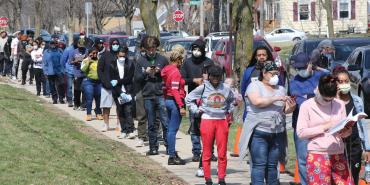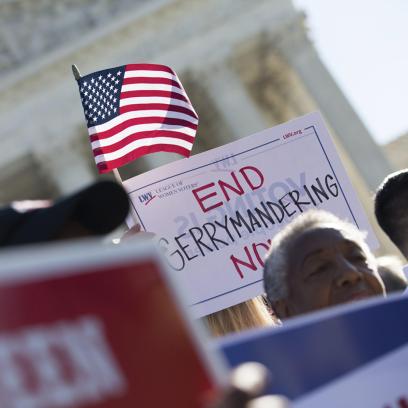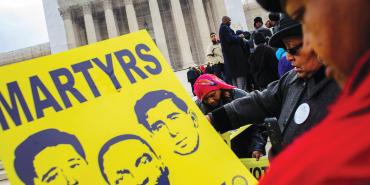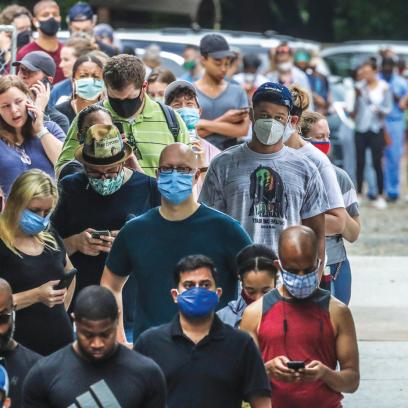Over the past decade, the students of North Carolina Agricultural & Technical State University (N.C. A&T) in Greensboro, North Carolina, the largest historically Black public university in the country, were forced into the spotlight of a national fight over voting rights that has been profoundly reshaping our democracy. During the 2018 midterm elections, students on campus, the vast majority of whom are African American, were split into two separate congressional districts. Depending on which dorm you lived in, you either voted in the 6th Congressional District or the 13th Congressional District.
To make the situation even more confusing, for the three prior congressional elections in 2012, 2014, and 2016, students on campus voted in the state’s 12th Congressional District. What changed? Federal courts found that North Carolina’s congressional map, which was drawn during the redistricting process in 2011, illegally diluted the voting power of people of color by a process known as cracking or packing voters. Put another way, the state legislature used gerrymandering (the practice of drawing electoral lines to benefit one party) to create congressional districts that unfairly diminished the voting power of people of color in the state. When the leadership in the state legislature was forced to redraw the map, they replaced their illegal racial gerrymander with a partisan gerrymander. The resulting map drew a line directly through the center of the N.C. A&T campus. The students went from being represented by Alma Adams, a Democratic member of the Congressional Black Caucus, to two Republicans. In short, students who had been packed by racial gerrymandering were cracked by partisan gerrymandering.
We don’t need to guess at the intent of those in the state legislature who were in charge of drawing the maps—one of them announced1 that he was drawing a map that gave Republicans 10 seats and Democrats 3 seats in the congressional delegation only because it was not mathematically possible to draw 11 seats for his Republican Party. While this was a particularly brazen instance of voter suppression because the culprit was willing to admit the misdeed, the truth is that it’s part of a much larger project that has taken place over the past decade that has undermined voting rights in America.
New Forms of Voter Suppression
The sad truth is that the poll tax and Jim Crow–era laws may be relics of bygone periods, but they have been replaced by new forms of discrimination and voter disenfranchisement that are very real and pervasive problems across America.
As is so often the case in American history, progressive steps forward are often met by resistance and backlash. In this case, the election of Barack Obama by a young, diverse coalition of supporters was followed by a new movement of voter suppression. Instead of actively trying to court this rising electorate, too many Republicans set about undermining the principle of “one person, one vote” so they could minimize the voting power of those who disagree with their views.
This work has been done using a number of tools, but the most prominent remain partisan and racial gerrymandering and stringent voter ID laws that overwhelmingly impact people of color and people who are poor. Voter suppression has allowed politicians to hold onto power despite often being out of step with voters on issues such as gun safety, climate change, reproductive rights, and funding for public schools and higher education.
There have been three defining moments in these efforts, each of which I explore below:
- the redistricting that occurred in 2011,
- the United States Supreme Court’s disastrous Shelby County decision that enabled voter restrictions (which, under my direction, the United States Department of Justice opposed) in 2013, and
- the US Supreme Court’s decision in Rucho v. Common Cause that declared federal courts would play no role in policing partisan gerrymandering in 2019.
A New Tool
During the 2010 elections, Republicans launched what they called Project RedMAP,2 which was short for the Redistricting Majority Project. They knew that following the Census in 2010, states would have to go through the once-a-decade redistricting process to redraw the maps for state legislatures and the United States House of Representatives. They executed a plan to spend $30 million on state legislative races so that Republicans would control the process in a number of key swing states.
Although gerrymandering has been around since the earliest days of America, what happened in 2011 was without precedent. Throughout most of our history, gerrymandering entailed incumbent politicians protecting themselves. In 2011, politicians used sophisticated mapping technology and an extreme desire for power to draw maps that were some of the most anti-democratic in history. Sam Wang and Brian Remlinger from the Princeton Gerrymandering Project write in a 2017 report3 that, “thanks to technology and political polarization, the effects of partisan gerrymandering since 2012 have been more pronounced than at any point in the previous 50 years.”
The effects of this gerrymandering were both immediate and enduring. In 2012, Democrats won 1.4 million more votes than Republicans in races for the US House of Representatives,4 but Republicans won a 33-seat majority in the chamber. There have been similar results at the state legislative level. In Wisconsin, for example, Republicans won 48.6 percent of the two-party vote statewide in 2012, but they “won” 60 of the 99 seats5 in the state Assembly.
The gerrymandered maps have been incredibly durable over the past decade. It took an historic “blue wave” during the midterms of 2018 for Democrats to finally win back a majority in the US House of Representatives and win control of a number of state legislative chambers. Yet, a study conducted by the Associated Press6 found that Republican gerrymandering likely prevented Democrats from winning an additional 16 seats in the House and flipping control of an additional seven state legislative chambers.
Gerrymandering fundamentally undermines democracy because it effectively predetermines which party will have control before a ballot is ever cast. The consequences last well beyond Election Day: gerrymandering is one of the driving forces of polarization in America. When politicians represent districts that have been drawn to favor their own party, they become more concerned with a primary challenge than an opponent from the opposite party in the general election. By creating an incentive for politicians to cater to the extremes of their base and their special-interest donors, they no longer feel compelled to do what is in the best interest of the vast majority of the people. They can ignore the wishes and interests of most of their constituents and face no electoral consequence.
The Center for American Progress has conducted a study of states where gerrymandering has meant that the Republican Party has won fewer votes but retains control of the states’ legislatures. Despite having popular support, the legislatures in many of these states have refused to expand Medicaid,7 take reasonable actions that would reduce gun violence,8 or invest in early childhood care and education.9 To use one example, in 2019 Governor Gretchen Whitmer of Michigan proposed a budget with an $84 million increase in funding for the state’s preschool programs, but the gerrymandered legislature cut that down to a paltry $5 million increase.10 Gerrymandering truly has life or death consequences for the American people and the future of our children.
A Supremely Bad Decision
If the gerrymandering that occurred in 2011 were the only attack on voting rights over the past decade, it would have been bad enough. Unfortunately, in 2013 the US Supreme Court, in a 5–4 decision, opened the floodgates for a renewed attack on who can cast a ballot in America.
Since 1965, Section 5 of the landmark Voting Rights Act had required what were called “covered jurisdictions” to preclear any changes to voting practices in their states with the US Department of Justice. Most, but not all, of the counties and states covered under Section 5 were former states of the Confederacy. The common denominator among them was that they all had Jim Crow voting provisions that targeted African Americans. For decades, the Voting Rights Act was renewed with bipartisan support in the US Congress, including in 2006 when it passed the Senate unanimously and was signed into law by President George W. Bush.
In 2013, the US Supreme Court decided Shelby County, a case that was originally brought in Alabama. In one fell swoop, the conservative majority on the Court ended decades of precedent and eliminated the preclearance process. As Justice Ruth Bader Ginsburg said in her prescient dissent, “throwing out preclearance when it has worked and is continuing to work to stop discriminatory changes is like throwing away your umbrella in a rainstorm because you are not getting wet.”
Starting immediately after the decision, 19 states—including 9 that previously had been covered jurisdictions under Section 5 of the Voting Rights Act—attempted to enact or successfully enacted voting restrictions like unnecessary photo ID laws. States have done so under the guise of “electoral integrity” and unsubstantiated claims of widespread voter fraud that are simply not backed up by any facts. A landmark report on voter fraud conducted by the Brennan Center found that an individual is more likely to “be struck by lightning”11 than to cast a fraudulent in-person ballot. Yet over the past decade, 27 states have sought to enact some form of photo ID or voter suppression law.
It’s not a coincidence that the most gerrymandered state legislatures passed some of the most restrictive voter ID laws. In North Carolina, a federal judge found that a voter ID law targeted African Americans with “almost surgical precision.”12 In Texas, a voter ID law allows people to vote using a state-issued concealed carry permit, but not a state-issued University of Texas student ID. In Wisconsin—a state Hillary Clinton lost by 23,000 votes in 2016—a voter ID law prevented up to 45,000 people13 from voting in 2016. In the spring of 2018, the US Supreme Court allowed the Republican secretary of state in Ohio to continue purging voters from the rolls, a practice that will likely become14 more widespread if Republicans continue to hold power at the state level.
The gubernatorial election of 2018 in Georgia between then Secretary of State Brian Kemp and former Georgia House Minority Leader Stacey Abrams provides even more examples of modern day, textbook voter suppression.15 The fact that Brian Kemp failed to recuse himself from his role as secretary of state during the campaign meant that he was essentially the referee in a game he was also playing—and he had no scruples about using this to his own advantage. As secretary of state, he purged 1.4 million voters from the rolls. In the run up to the election, his office stalled the voter registration of more than 50,000 people,16 80 percent of whom are people of color. Then on Election Day, voters in predominantly minority communities were forced to wait in lines for hours while voting machines sat in government warehouses unused. Kemp ended up beating Abrams by a mere 55,000 votes out of nearly 4 million cast, ending her bid to be the first African American woman elected governor in the history of the country.
A Misplacement of Power
In 2019, the US Supreme Court struck one more blow to voting rights by refusing to rein in partisan gerrymandering. During the Court’s term, they heard oral arguments in two separate but related cases. The first case involved the partisan gerrymandering of the North Carolina congressional delegation—this is the same map that split the N.C. A&T campus in half and gave Republicans a 10–3 seat advantage in what is essentially a 50–50 state.17 The second case involved a Democratic gerrymander of a single congressional district in Maryland. Taken together, the justices had the opportunity to say that no matter which party is at fault, and both were, partisan gerrymandering violates the Constitution.
Instead, in another 5–4 decision, the conservative justices determined in Rucho v. Common Cause that federal courts have no role in preventing partisan gerrymandering. In effect, the Court found that partisan gerrymandering created a real harm, but that it should be left up to the states to determine how to remedy the problem. To point out the unprecedented nature of this ruling, Justice Elena Kagan wrote in her powerful dissent18 that “for the first time ever, this Court refuses to remedy a constitutional violation because it thinks the task beyond judicial capabilities.” She went on to write that the partisan gerrymanders in Maryland and North Carolina “debased and dishonored our democracy, turning upside-down the core American idea that all governmental power derives from the people.”
Restoring Fairness
Despite the various barriers and attempts to block the American people from having the ability to elect candidates of their choice, all hope is not lost. There are a number of avenues we can pursue to fight gerrymandering in the lead-up to the redistricting process that will take place in 2021. The organization I lead, the National Democratic Redistricting Committee (NDRC), will continue to use every tool at our disposal—reform efforts, litigation, state and local election victories, and citizen advocacy—to restore fairness to our democracy.
Over the past few years, there has been a groundswell of support for anti-gerrymandering measures at the state level. In 2018 alone, citizens in Colorado, Michigan, Missouri, Ohio, and Utah supported ballot measures that would either create citizen-led independent redistricting commissions to draw the lines or significantly reform the process to make it less partisan.19 As we have seen in states like Arizona and California that have citizen-led commissions in place, this is the best way to draw new lines because it removes power from self-interested politicians and gives it back to the people, where it belongs.
On the litigation front, although the US Supreme Court has said that federal courts will not police partisan gerrymandering, there are still two options for bringing cases. The first is racial gerrymandering claims brought in federal courts that prevent states from cracking and packing minority voters in a way that violates Section 2 of the Voting Rights Act. In 2019, while the US Supreme Court failed to take action on partisan gerrymandering, a majority did uphold the redrawing of 11 state legislative districts in Virginia that were unfairly drawn based on race in a case brought by an affiliate of the NDRC.
The other remedial option is to bring partisan gerrymandering claims in state courts under state constitutions, which often have stronger voting rights protections than the federal Constitution. In 2019 an affiliate of the NDRC successfully brought partisan gerrymandering claims in North Carolina based on the state constitution that ultimately forced the redrawing of the state legislative and congressional maps. This case finally remedied the disenfranchisement of the students of N.C. A&T.
Politically, it is incumbent upon all of us to focus on, and care more about, the state and local politicians we elect. Although the positions may not be as glamorous as a US senator or the president, the people we elect to serve us at the local level often have a greater impact on our day-to-day lives. Not only do these people often have control over the redistricting process, they also control funding for education, healthcare, and so many of our other pressing needs. We should all endeavor to pay more attention to these important local offices and the people we elect to fill them.
At this moment when our political system is being tested in so many ways, the American people cannot take our democracy for granted. The silver lining is that since January 2017, there has been an awakening amongst our fellow citizens, a new activism that has been led by ordinary Americans realizing the power that we all have as citizens. I have been inspired by, among others, the actions of concerned women, activist teachers, LGBTQ Americans, those in systemically distressed communities of color, and students devastated by gun violence who have marched and organized to demand fairness, opportunity, and justice. But in too many places, regardless of political affiliation, age, or race, people feel that our system of government is breaking down. For too many, our democracy is not working. As a result, the issues that are of greatest concern—our education system, income inequality and stagnant wages, racial injustice, climate change, immigration, and personal freedoms—are not meaningfully addressed.
Despite the many challenges we face as a nation, this is not a time for despair. Our history has shown that we should never underestimate what is possible when Americans come together to shape the fate of our nation. I am optimistic, despite the efforts of one party abetted by a misguided US Supreme Court, that the will of the American people—and not the special interests—will triumph. We need to stand up for our values and our rights, and to use consistently the most powerful tool we all have as citizens: the vote. Together, we—the people—can bring about a new era of change and progress and stay true to our founding ideals.
America is both exceptional and a work in progress. We can and must commit ourselves to constructing a nation that stays true to the ideals that have always defined us. This is our ultimate challenge and enduring responsibility as 21st century American patriots.
Eric H. Holder, Jr., serves as chair of the National Democratic Redistricting Committee (democraticredistricting.com). He served in the Obama Administration as the 82nd Attorney General of the United States from February 2009 to April 2015, the third longest serving attorney general in US history and the first African American to hold that office.
Endnotes
1. D. Graham, “North Carolina’s Landmark Ruling Against Partisan Gerrymanders,” The Atlantic, January 9, 2018, https://www.theatlantic.com/politics/archive/2018/01/north-carolina-par….
2. The Redistricting Majority Project, 2012 RedMAP Summary Report, January 2013, http://www.redistrictingmajorityproject.com/?p=646.
3. S. Wang and B. Remlinger, “Slaying the Partisan Gerrymander,” The American Prospect, September 25, 2017, https://prospect.org/power/slaying-partisan-gerrymander/.
4. S. Wang, “The Great Gerrymander of 2012,” New York Times, February 2, 2013, https://www.nytimes.com/2013/02/03/opinion/sunday/the-great-gerrymander….
5. M. Li and T. Wolf, “5 Things to Know About the Wisconsin Partisan Gerrymandering Case,” Brennan Center for Justice, June 19, 2017, https://www.brennancenter.org/our-work/analysis-opinion/5-things-know-a….
6. D. Lieb, “GOP Won More Seats in 2018 Than Suggested by Vote Share,” Associated Press, March 21, 2019, https://apnews.com/9fd72a4c1c5742aead977ee27815d776.
7. A. Tausanovitch and E. Gee, “How Partisan Gerrymandering Limits Access to Healthcare,” Center for American Progress, February 24, 2020, https://www.americanprogress.org/issues/democracy/reports/2020/02/24/48….
8. A. Tausanovitch, C. Parsons, and R. Bhatia, How Partisan Gerrymandering Prevents Legislative Action on Gun Violence (Washington, DC: Center for American Progress, December 2019): https://www.americanprogress.org/issues/democracy/reports/2019/12/17/47….
9. A. Tausanovitch et al., How Partisan Gerrymandering Hurts Kids (Washington, DC: Center for American Progress, 2020): https://www.americanprogress.org/issues/democracy/reports/2020/05/28/48….
10. Tausanovitch et al., How Partisan Gerrymandering Hurts Kids.
11. J. Levitt, The Truth about Voter Fraud (New York City, NY: Brennan Center for Justice, 2007) https://www.brennancenter.org/sites/default/files/legacy/The%20Truth%20….
12. C. Domonoske, “Supreme Court Declines Republican Bid to Revive North Carolina Voter ID Law,” The Two-Way (blog), NPR, May 15, 2017, https://www.npr.org/sections/thetwo-way/2017/05/15/528457693/supreme-co….
13. A. Berman, “Rigged: How Voter Suppression Threw Wisconsin to Trump,” Mother Jones, December 2017, https://www.motherjones.com/politics/2017/10/voter-suppression-wisconsi….
14. P. Williams, “Supreme Court Gives Ohio Right to Purge Thousands of Voters From its Rolls,” NBC News, June 11, 2018, https://www.nbcnews.com/politics/supreme-court/ohio-wins-supreme-court-….
15. M. Astor, “Georgia Governor Brian Kemp Faces Investigation by House Panel,” New York Times, March 6, 2019, https://www.nbcnews.com/politics/supreme-court/ohio-wins-supreme-court-….
16. “Voting Rights Become A Flashpoint In Georgia Governor’s Race,” WABE, October 9, 2018, https://www.wabe.org/voting-rights-become-a-flashpoint-in-georgia-gover….
17. Voter Registration Statistics (NC, North Carolina State Board of Elections, 2020) https://vt.ncsbe.gov/RegStat/Results/?date=06%2F06%2F2020.
18. Rucho et al. v. Common Cause et al., no. 18–422; US, (June 27, 2019) https://www.supremecourt.gov/opinions/18pdf/18-422_9ol1.pdf.
19. A. Lo, “Citizen and Legislative Efforts to Reform Redistricting in 2018,” Brennan Center for Justice, November 7, 2018, https://www.brennancenter.org/our-work/analysis-opinion/citizen-and-leg….
20. N. Reimann, “Coronavirus Infections Spiked in Wisconsin after In-Person Election, Study Says,” Forbes, May 19, 2020, https://www.forbes.com/sites/nicholasreimann/2020/05/19/coronavirus-inf….
21. “Coronavirus in African Americans and Other People of Color,” Johns Hopkins Medicine, April 20, 2020, https://www.hopkinsmedicine.org/health/conditions-and-diseases/coronavi….
22. K. Moore et al., COVID-19: The CIDRAP Viewpoint (Minnesota: Center for Infectious Disease Research and Policy, April 2020) https://printabletemplates.com/cidrap-covid19-viewpoint/.
23. AD HOC Committee for 2020 Election Fairness and Legitimacy, Fair Elections During A Crisis: Urgent Recommendations in Law, Media, Politics, and Tech to Advance the Legitimacy of, and the Public’s Confidence in, the November 2020 U.S. Election (UCI Law: April 2020) https://www.law.uci.edu/faculty/full-time/hasen/2020ElectionReport.pdf.
24. R. Hansen, “Trump Is Wrong about the Dangers of Absentee Ballots,” Washington Post, April 9, 2020, https://www.washingtonpost.com/opinions/2020/04/09/trump-is-wrong-about…; S. Saul and E. J. Epstein, “Trump Is Pushing a False Argument on Vote-By-Mail Fraud. Here Are The Facts,” New York Times, June 2, 2020, https://www.nytimes.com/article/mail-in-voting-explained.html.
25. Saul and Epstein, “Trump Is Pushing a False Argument.”
26. D. Thompson et al., The Neutral Partisan Effects of Vote-by-Mail: Evidence from County-level Rollouts (Stanford, CA: Stanford Institute for Economic Policy Research, April 2020) https://siepr.stanford.edu/sites/default/files/publications/20-015.pdf; A. Bonica et al., All-Mail Voting in Colorado Increases Turnout and Reduces Turnout Inequality (Vote at Home, April 2020) https://www.voteathome.org/wp-content/uploads/2020/05/CO-All-Mail-Votin….





